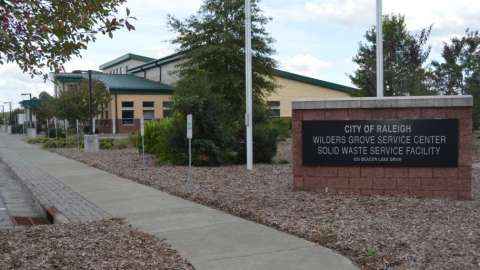Jump To:
Data on this page is updated annually.
The transition to sustainable energy is not just about using clean and renewable forms of energy. It is also about reducing the total energy the community uses and not wasting that energy – in other words, energy efficiency. Energy efficiency is the first step to sustainable energy because a building must be energy efficient before solar or renewable energy is installed. It also helps us save money and reduce our greenhouse gas emissions (GHG). Important first steps towards energy efficiency include analyzing energy use and improving existing facilities with new technology and equipment that helps us reduce energy use.
Two of the primary rating systems for the energy efficiency of new buildings are Leadership in Energy and Environmental Design (LEED) and ENERGY STAR. LEED is a building certification offered by the U.S. Green Building Council. The LEED certification process requires buildings to achieve above-code construction in energy and water efficiency and include other sustainability measures which encourage building occupants and users to adopt climate-friendly practices. Additionally, ENERGY STAR is a joint program through the U.S. Environmental Protection Agency (EPA) and U.S. Department of Energy (DOE) that offers similar standardization on sustainability metrics, scaling from appliances and lighting to entire homes and industrial facilities.
A growing number of developers and property managers are seeking these designations to improve environmental performance and save money long term. The designations recognize buildings that use less energy and produce few or no greenhouse gas emissions from carefully designed windows, HVAC, and other elements and systems.
In 2008, at the recommendation of the Environmental Advisory Board, the Raleigh City Council adopted a policy that all new City-owned buildings constructed that are greater than 10,000 square feet must be built to at least a LEED Silver standard, with a higher rating where practical and as funding is available. The City of Raleigh continues to pursue LEED certification of new buildings. In 2022 the Law Enforcement Training Center (LETC) achieved a LEED Gold certification and was a finalist for a 2022 Carolinas USGBC award. There are 150 LEED-certified buildings totaling over 13 million square feet and 135 Energy Star Buildings totaling over 17 million square feet in Raleigh. Please see the 2024 CCAP Implementation Report to learn more and see a list of LEED-certified City buildings.

Wilders Grove Solid Waste Services Facility, which has platinum-level LEED certification
How can I make my home or business more energy efficient?
Beyond City buildings, residential and commercial buildings can receive energy efficiency upgrades. The ENERGY STAR Home Upgrade has six high-impact improvements: clean heating and cooling, well-insulated and sealed attic, super-efficient water heater, high-performing windows or storm windows, smart thermostat, and electric ready. Newly constructed and upgraded homes that meet specific requirements and receive third-party verification can become ENERGY STAR-certified.
Similarly, commercial businesses can implement energy efficiency changes to become ENERGY STAR-certified. Changes could include lighting upgrades, operations and maintenance practices, energy-saving competitions, and renewable energy.
Having an ENERGY STAR-certified home or business can have several benefits from lower energy bills to higher worth to knowing you are reducing your greenhouse emissions. According to the ENERGY STAR website, ENERGY STAR-certified homes produce an average of 35% less emissions than non-certified homes.
Visit our Sustainable Business Toolkit to learn more about energy efficiency audit programs available to Raleigh residents.
Tracking Energy Use in City Facilities
The City of Raleigh uses a data management system called EnergyCAP. This software helps the City track energy and non-energy utility usage, benchmark buildings, capture utility bill data, monitor meter readings, plus analyze and spot trends that identify areas for potential energy savings. Overall electricity use in the City increased only slightly from 2020-2023, even with new buildings added. In 2024, electricity use was lower than in the previous year. In future years, the goal is to continue to reduce overall use through energy efficiency techniques. These include building controls, LED lighting, and upgraded HVAC and other systems.

The City's EnergyCAP software shows electricity use over recent years.
Energy Efficiency in City Buildings – Raleigh Water
Raleigh Water is the City’s largest power user, providing water and sanitary sewer services to a service population of over 630,000 people in Raleigh and surrounding areas. Raleigh Water has taken steps to identify and implement energy savings in operation of its water and wastewater treatment facilities. In 2018, a thorough assessment of energy usage at existing Resource Recovery Facilities was conducted, leading to strategies for future energy reduction. By 2023, the Neuse River Resource Recovery Facility was producing 629,000 gallons per day of reuse water, reducing the demand for potable water and preventing the release of approximately 3,000 pounds of nitrogen into the Neuse River.
